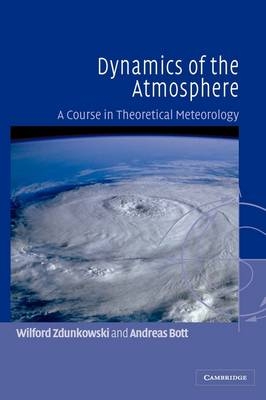
Dynamics of the Atmosphere
Cambridge University Press (Verlag)
978-0-521-80949-8 (ISBN)
Dynamics of the Atmosphere consists of two parts: the first presenting the mathematical tools needed for a thorough understanding of the topics covered in the second part of the book. The second part begins with the derivation of the equation describing the atmospheric motion on the rotating earth. Subjects tackled in subsequent chapters include kinematics of the atmosphere (including vorticity and circulation theorems), wave motion in the atmosphere, inertial and dynamic stability, and turbulent systems in the atmosphere. Finally, newer methods of weather prediction, such as the spectral technique and the stochastic dynamic method, are introduced in order to demonstrate their potential for extending the forecasting range. Complete with numerous exercise sets and solutions, this textbook has been written for advanced undergraduate and graduate students of meteorology and other related sciences. It may also be used as a reference source by professional meteorologists and researchers in atmospheric science.
Preface; M1. Algebra of vectors; M2. Vector functions; M3. Differential relations; M4. Coordinate transformations; M5. The method of covariant differentiation; M6. Integral operations; M7. Introduction to the concepts of nonlinear dynamics; 1. The laws of atmospheric motion; 2. Scale analysis; 3. The material and the local description of flow; 4. Atmospheric flow fields; 5. The Navier-Stokes stress tensor; 6. The Helmholtz theorem; 7. Kinematics of two-dimensional flow; 8. Natural coordinates; 9. Boundary surfaces and boundary conditions; 10. Circulation and vorticity theorems; 11. Turbulent systems; 12. An excursion into the spectral turbulence theory; 13. The atmospheric boundary-layer; 14. Wave motion in the atmosphere; 15. The barotropic model; 16. Rossby waves; 17. Inertial and dynamic stability; 18. The equation of motion in general coordinate systems; 19. The geographical coordinate system; 20. The stereographic coordinate system; 21. Orography-following coordinate systems; 22. The stereographic system with a generalised vertical coordinate; 23. A quasi-geostrophic baroclinic model; 24. A two-level prognostic model: baroclinic instability; 25. An excursion into numerical procedures; 26. Modeling of atmospheric flow by spectral techniques; 27. Predictability; Answers to problems; List of commonly used symbols; References; Index.
| Erscheint lt. Verlag | 10.4.2003 |
|---|---|
| Zusatzinfo | Worked examples or Exercises; 4 Tables, unspecified; 188 Line drawings, unspecified |
| Verlagsort | Cambridge |
| Sprache | englisch |
| Maße | 181 x 256 mm |
| Gewicht | 1610 g |
| Themenwelt | Naturwissenschaften ► Geowissenschaften ► Meteorologie / Klimatologie |
| Naturwissenschaften ► Physik / Astronomie ► Angewandte Physik | |
| ISBN-10 | 0-521-80949-5 / 0521809495 |
| ISBN-13 | 978-0-521-80949-8 / 9780521809498 |
| Zustand | Neuware |
| Haben Sie eine Frage zum Produkt? |
aus dem Bereich


